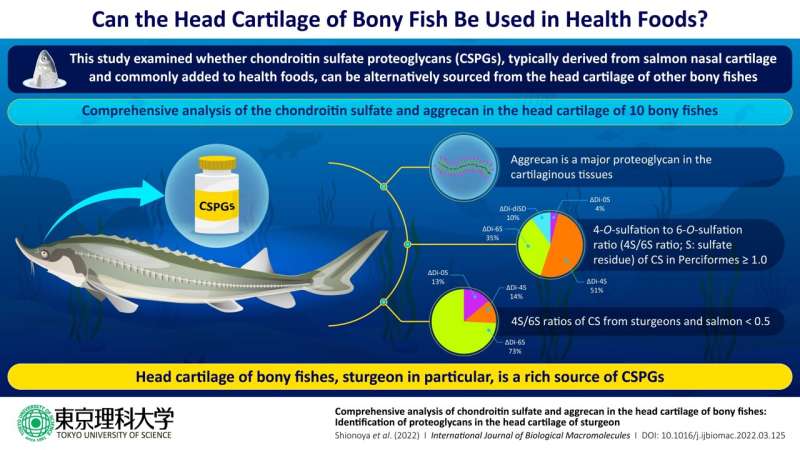
Aggrecan, a major component of
proteoglycan (PG) having chondroitin sulfate (CS) in cartilaginous tissues, has
become increasingly popular as an ingredient in health food. In fact,
proteoglycans from salmon nasal cartilage demonstrate biological properties
such as antiaging, inhibition of angiogenesis, and attenuation of inflammatory
responses. Commercially available chondroitin sulfate proteoglycans (CSPGs)
have only been prepared from salmon nasal cartilage. Although the head
cartilage was found in other edible bony fishes, there is little information on
the composition of core proteins and their CS structures in the head cartilage.
Now, in a new study published in the International Journal of Biology Macromolecules, a team of researchers led by Associate Professor Kyohei Higashi of Tokyo University of Science, and Dr. Naoshi Dohmae and Dr. Takehiro Suzuki of the RIKEN Center for Sustainable Resource Science tackles this question. "We found that composition of PGs and their CS structure in the skull of the Siberian sturgeon and Russian sturgeon were similar to that in the salmon nasal cartilage," reports Dr. Higashi. The fishes for the study were provided by Mr. Atsuhi Nakamura from Miyazaki Prefectural Fisheries Research Institute. This study was made available online on March 23, 2022 and was published in Volume 208 of the journal on May 31, 2022.
All the fishes examined contained abundant CSPGs in the head cartilage. Comprehensive analysis of CS structure in PGs derived from 10 bony fishes revealed that the structure of CS derived from Perciformes were similar to that of CS derived from cartilage of terrestrial animals. On the other hand, the structure of CS from skull of sturgeons was similar to that of CS from salmon nasal cartilage. In addition, they also found that aggrecan, a major CSPG in the cartilaginous tissue, was conserved in 10 bony fishes. In fact, the aggrecan protein from LOC117428125 and LOC117964296 genes registered in the National Center for Biotechnology Information database was found to be abundant in the skull of sturgeons. Furthermore, compositions of other PGs, collagens, and matrix proteins in the skull of sturgeons were similar to that of salmon nasal cartilage.
Elaborating on the findings of this study, Dr. Kyohei Higashi says that "head cartilage from bony fishes is an underutilized resource and is typically discarded after food processing. The PGs, especially from the sturgeon, are similar in CS structure to the salmon nasal cartilage, showing that the sturgeon has a lot of potential to be an alternative source of CSPGs for health food formulations."

 Previous page
Previous page Back to top
Back to top







